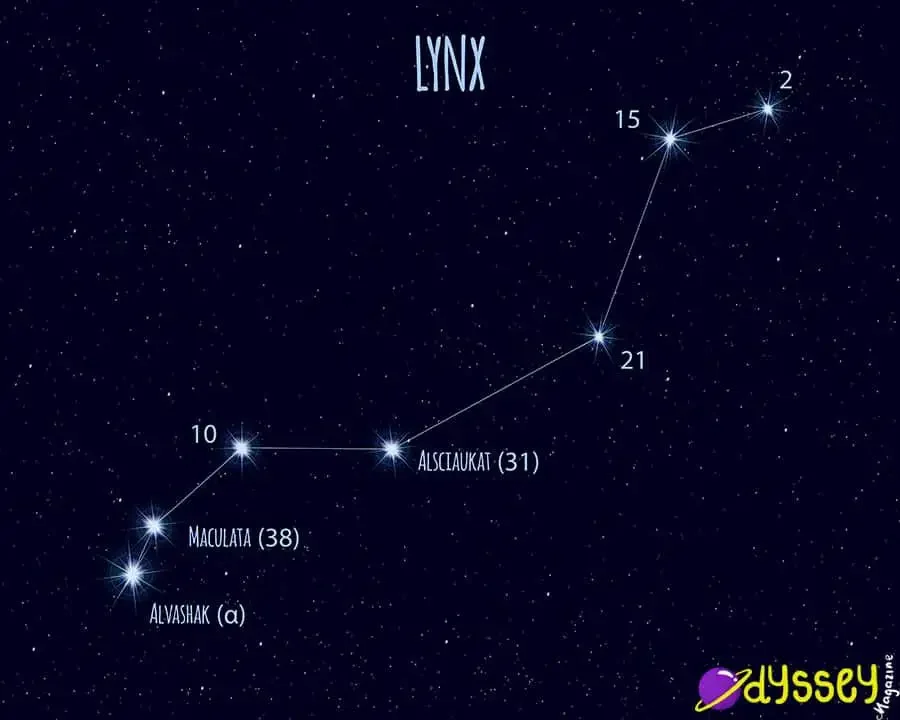Lynx Constellation
With most of the constellations taking their names from Greek and Roman words, Lynx definitely stands out from the rest. It has a unique name (which I’ll get to in a little while), with many people wondering where it got its name from. It is bordered on the well known constellation Ursa Major, as well as other constellations of the Zodiac, like Gemini, Cancer and Leo. We’re going to look at Lynx in a little more detail.
- Bordered By; Ursa Major, Camelopardalis, Auriga, Gemini, Cancer, Leo (corner), Leo Minor.
- Named after; The Lynx
- Declination; +45°
- Brightest Star; Alpha Lyncis
- Best seen; March
- Size rank; 28th
- Constellation family; Ursa Major
- Pronunciation; LINKS
Many people think that this constellation takes its name from the animal the Lynx. It does, but probably not in the way that you think. I mean – it looks pretty much nothing like a Lynx, right? Well, it actually takes its name from the fact that you’d need the eyesight of a Lynx to actually see the constellation, because it’s so faint!
This constellation was actually discovered by Polish astronomer Johannes Hevelius, who also referred to the constellation as Tiger (likely due to the same reason as the Lynx). Hevelius is known for finding many different constellations up in our night sky, including other constellations like Scutum and Sextans.
As one of the fainter constellations in the sky, it can be pretty difficult for you to actually see Lynx in the night sky. The good news is that you can see this constellation if you’re in the Northern hemisphere, and the best time of year in terms of visibility is March-April.
In terms of proximity, Lynx is actually quite wide, however it is very thin. The stars themselves are fairly faint, so you’ll likely need to see a few of them together to actually be able to identify the constellation itself.

- Alpha Lyncis (α) – Lynx is best found by looking for its brightest star, which is referred to as Alpha Lyncis. It may also be referred to as Alvashak or Elwashak, which is taken from the Arabic El Washaq, which literally means the Lynx. Out of all the stars of this constellation, it is the only one with a Bayer designation – this means that it is the Alpha of the constellation, and there is no Beta or Delta. Although it is the brightest, it is still only a giant star with a fairly low temperature.
- 38 Lyncis – The start 38 Lyncis is actually quite close to us, with it only being approximately 125 light years away from the Sun. It is a combination of a main sequence star and another fainter star, which make up a double star system. It is around twice the temperature of Alpha Lyncis, which gives the star a blue color, and is said to have 30x the luminosity of the Sun too.
- 10 Ursae Majoris – Another binary star which is the third brightest in this constellation is Ursae Majoris. As you may have guessed, it is named as such as it was once part of the Ursa Major constellation, though it has been established within Lynx for some time now. At only 50 light years away from Earth, it is one of the closer stars to our planet.
- 31 Lyncis – The next star is known as 31 Lyncis, but it is also commonly called Alsciaukat. Roughly translated from the Arabic for thorn (Al Shaukah), it is right in the center of the constellation. It is a little further away than the others at 380 light years away, and it is more than a billion years old too.
- 15 Lyncis – You might be able to identify 15 Lyncis from the other stars due to its yellowish color. It is actually made up of two different stars orbiting each other, with the larger of the two being a giant star.
- 21 Lyncis – One of the fainter stars in the constellation, it can be difficult for people to spot 21 Lyncis in the night sky. Even though it is faint, it actually has an almost 10,000K temperature and is more than 100x as luminous as the Sun.
- 2 Lyncis – Another star that is faint but still visible to the naked eye is 2 Lyncis. A binary star system, it is gradually making its way towards the Sun (but very, very, very slowly!).
To sum it up, the Lynx constellation is another interesting one, if only for the fact that its name is nothing like the pattern you’ll find in the night sky. Although it can be difficult to spot, during the Springtime in the US or the UK you should be able to find Lynx. Often, you can look for Ursa Major or the big dipper first to identify where Lynx is.





